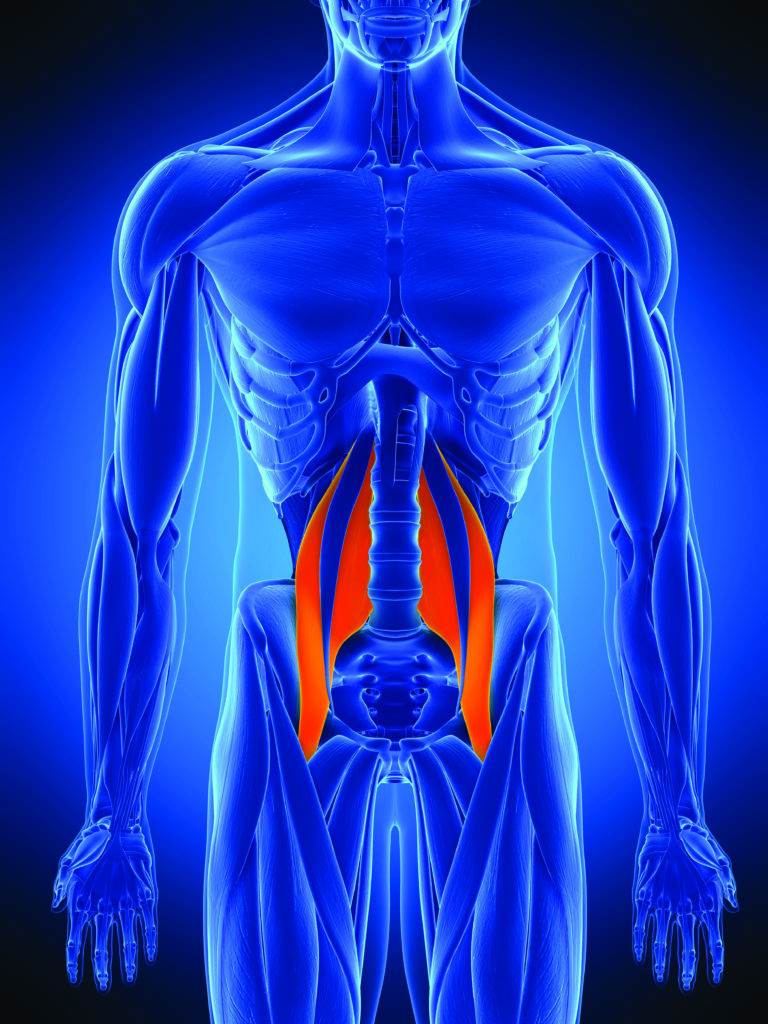Do you trust me?
Like a road that starts in the plains, crosses mountains, desert, hills, and ends by the sea, your psoas muscle covers a lot of terrain. This muscle is integral in sitting, walking, and standing, as well as forward and back ward bending—all of your essential movements. It connects upper and lower body, rib cage with pelvis, and mid-back with thighs. Given all of this, it’s worthwhile to spend a little time getting to know it better.
Let’s look at the specific geography. The psoas originates at the base of your ribcage, at the twelfth thoracic vertebra. It inserts (or ends) at the lesser trochanter of your thigh bone. This is a knobby point of bone on the inner upper thigh, high up in your groin, part of what is called your “pelvic floor.”
Within the psoas muscle, there are different qualities in different areas. In the northern portion where it originates at your rib cage, psoas is ropey and attaches to the spine and discs. As we move south, psoas spreads out, becoming broader and flatter.
In the pelvis psoas lines the front of your hipbones, not unlike the way a piecrust lines a pie plate (a phrase borrowed from my yoga teacher Donald Moyer). Think about that for a minute. If we tune into the quality of the muscle within the pelvis we can feel where it has gotten bunched up like a crust with wrinkles in it, and invite release, like a rolling pin evening out the dough. Psoas returns to a more ropey quality south of the pelvis to insert at your inner upper thighbone.
Let’s look at some of the key players in the psoas geography. Nearby the psoas origin are the lower or “floating” ribs, breathing diaphragm, kidneys, and adrenals. We can consider each of these to be neighbors or house mates. Do you know how it is when your roommate comes home all agitated and upset? It can be very hard to fully separate yourself from their angst. In the same way, the humor or state of being of physical structures in your body can influence one another.

The interface between psoas and your breathing diaphragm means that the state of this muscle and breathing are intimately inter twined. A tight psoas can influence breathing . . . likewise a restricted diaphragm can influence psoas. Restricted breathing will influence overall health and well-being in time. The lungs are the bellows nourishing the digestive fire. If you cannot breathe freely, your digestion will be thrown off, leading to a cycle of less energy, less resilience, more vulnerability to illness.
Your kidneys and adrenals are right there in the mix too, located at the base of the ribcage, rubbing up against psoas, massaged by the breathing diaphragm. These internal organs are fundamental in the fight/flight action-oriented sympathetic nervous system response. If the psoas is tight, your breathing can become restricted and the internal organs will be going overtime. Or if you are not able to settle down and relax, the adrenals won’t quit, psoas will be influenced to contract, and it’s hard to take a deep breath. Sound familiar?
As you are starting to see, psoas is intimately intertwined with your nervous system. This muscle is fundamental to the sympathetic/parasympathetic response. Sympathetic state is often called, “fight/flight” and is an action-oriented state. Parasympathetic state, or “rest and digest,” is a calm state of receptivity.
When you feel safe, psoas relaxes, your pelvis opens, you breathe easily, stand tall, and are receptive. When you feel threatened, psoas contracts, your pelvis pulls back, breathing is restricted, and you are vigilant. Psoas knows, “This I trust, this I don’t.”
The sensitivity and attunement of psoas makes it a great tool for knowing how you truly feel. We might call it your “gut feeling” about people, places, and things. Let’s try an experiment. Think of a place where you feel unsafe. A place where you feel threatened or intimidated. A dark alley at night comes to mind for me. What is the feeling in your body? How are you breathing? What does your pelvis feel like? For many, it gets very hard to feel their body in such a circumstance. See if you can slow down and feel, for just a moment. Is it difficult to breathe? Is there an achiness in your back? This is a tight, contracted psoas, ready for action.
Now open your eyes, take a few deep breaths, and let’s try something else. Think about a place you love, a place where you can deeply relax, where you feel at home. A beach with warm sand and sun comes to mind for me. Or cool moss at the foot of a shady tree on a warm day. Now recognize that feeling in your body. Notice your breathing. Do the ribs spread evenly as you breathe in and out? Notice your pelvis. Does it feel open, stable, comfortable? Can you breathe freely? This is the feeling of being at ease. This is a long, luxurious psoas.
A long and luxurious psoas is delicious. It feels as though your legs begin at the base of the ribs. Standing tall and walking with ease in your stride comes naturally when psoas is released. This is a delight to experience, and is your birthright. You deserve to be at ease in your body and mind. Let psoas be your guide to better knowing how you really feel in each moment.
Cator Shachoy is a longtime yogi, healer, and teacher in the SF Bay Area. She is fascinated by the mysterious indivisibility of mind, body, and heart. CatorShachoy.com